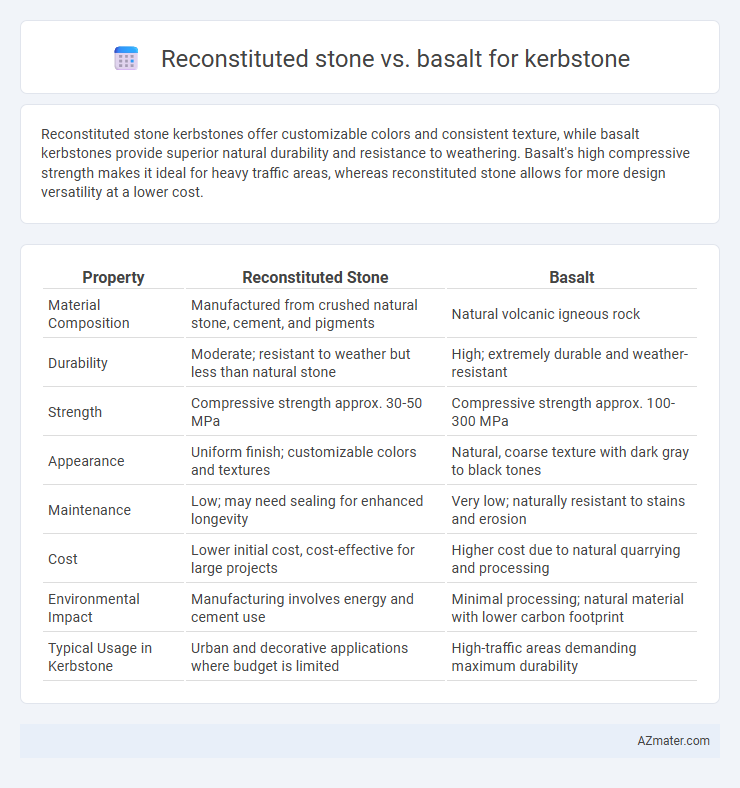Reconstituted stone kerbstones offer customizable colors and consistent texture, while basalt kerbstones provide superior natural durability and resistance to weathering. Basalt's high compressive strength makes it ideal for heavy traffic areas, whereas reconstituted stone allows for more design versatility at a lower cost.
Table of Comparison
| Property | Reconstituted Stone | Basalt |
|---|---|---|
| Material Composition | Manufactured from crushed natural stone, cement, and pigments | Natural volcanic igneous rock |
| Durability | Moderate; resistant to weather but less than natural stone | High; extremely durable and weather-resistant |
| Strength | Compressive strength approx. 30-50 MPa | Compressive strength approx. 100-300 MPa |
| Appearance | Uniform finish; customizable colors and textures | Natural, coarse texture with dark gray to black tones |
| Maintenance | Low; may need sealing for enhanced longevity | Very low; naturally resistant to stains and erosion |
| Cost | Lower initial cost, cost-effective for large projects | Higher cost due to natural quarrying and processing |
| Environmental Impact | Manufacturing involves energy and cement use | Minimal processing; natural material with lower carbon footprint |
| Typical Usage in Kerbstone | Urban and decorative applications where budget is limited | High-traffic areas demanding maximum durability |
Introduction to Kerbstone Materials
Kerbstone materials are essential for defining edges and providing structural support in urban landscapes. Reconstituted stone offers a versatile, cost-effective option combining crushed natural stones with resins for durability and aesthetic variety. Basalt, a natural volcanic rock, is prized for its strength, weather resistance, and long-lasting performance in high-traffic environments.
What is Reconstituted Stone?
Reconstituted stone is a man-made material composed of crushed natural stone bound together with cementitious or resinous binders, offering uniformity in texture and color ideal for kerbstone applications. Basalt, a dense volcanic rock, provides excellent durability and natural resistance to weathering, making it a preferred choice for heavy-duty kerbstones in high-traffic areas. Reconstituted stone allows for cost-effective production with customizable shapes and finishes, while basalt delivers superior strength and natural aesthetic appeal.
Understanding Basalt as a Kerbstone Material
Basalt is a dense, durable igneous rock characterized by its fine-grained texture and high compressive strength, making it an ideal kerbstone material capable of withstanding heavy traffic loads and harsh weather conditions. Unlike reconstituted stone, which is manufactured from crushed stone and binding agents, basalt offers natural resistance to abrasion, chemical corrosion, and freeze-thaw cycles, enhancing the longevity and structural integrity of kerbstones. Its dark color and consistent appearance contribute to both functional and aesthetic benefits in urban landscaping projects.
Durability Comparison: Reconstituted Stone vs Basalt
Reconstituted stone kerbstones offer controlled durability through engineered composition, ensuring resistance to weathering and mechanical stress. Basalt kerbstones naturally exhibit exceptional hardness and long-lasting durability due to their volcanic origin, making them highly resistant to abrasion and impact. Compared to reconstituted stone, basalt generally surpasses in longevity and strength, making it ideal for heavy traffic and harsh environmental conditions.
Aesthetic Differences Between Reconstituted Stone and Basalt
Reconstituted stone offers a versatile range of colors and textures, allowing for uniformity and customizable aesthetic appeal in kerbstone applications. Basalt provides a natural, dark gray to black hue with a dense, fine-grained texture that emphasizes durability and a more organic, rugged appearance. The choice between reconstituted stone and basalt influences visual consistency and design flexibility, with reconstituted stone suited for precise, clean finishes and basalt favored for its authentic, timeless look.
Installation and Workability Factors
Reconstituted stone offers easier installation for kerbstones due to its uniform shape, consistent size, and lighter weight compared to basalt, reducing labor time and effort. Basalt's natural density and hardness provide superior durability but require specialized tools and skilled labor for cutting and fitting, increasing installation complexity. The workability of reconstituted stone allows for faster customization and adjustment on-site, while basalt demands precise planning to accommodate its rigidity and fragmentation risk during handling.
Environmental Impact and Sustainability
Reconstituted stone kerbstones use crushed natural aggregates and binders, typically reducing the reliance on quarrying compared to basalt, which is extracted through intensive mining with significant habitat disruption. Basalt kerbstones have a longer lifespan and higher durability, decreasing replacement frequency, but their extraction and transportation result in higher carbon emissions. Sustainable urban projects favor reconstituted stone for its use of recycled materials and lower embodied energy, aligning better with environmental impact reduction goals.
Cost Analysis: Budget Considerations
Reconstituted stone offers a cost-effective solution for kerbstones due to lower material and manufacturing expenses compared to natural basalt, which involves higher quarrying and transportation costs. Installation costs for reconstituted stone can also be reduced because of its uniform size and lighter weight, leading to faster handling and less labor. However, basalt's durability and low maintenance over time may offset its higher upfront price, making it a critical factor in long-term budget planning.
Maintenance Requirements Over Time
Reconstituted stone kerbstones typically demand less maintenance over time due to their uniform composition and resistance to weathering and staining, reducing the need for frequent cleaning and repairs. Basalt kerbstones, while extremely durable and resistant to abrasion, may require periodic sealing to prevent surface erosion and maintain their aesthetic appeal. The lower porosity of reconstituted stone minimizes water absorption, thereby decreasing the risk of cracking and moss growth compared to natural basalt.
Which Material is Best for Your Project?
Reconstituted stone offers consistent coloration, customizable shapes, and easier installation, making it ideal for projects requiring aesthetic precision and uniformity in kerbstones. Basalt provides superior durability, natural strength, and weather resistance, suitable for heavy-traffic areas and long-lasting performance. Selecting the best material depends on project priorities: opt for reconstituted stone for design flexibility and cost-effectiveness or basalt for maximum hardness and environmental resilience.

Infographic: Reconstituted stone vs Basalt for Kerbstone
 azmater.com
azmater.com